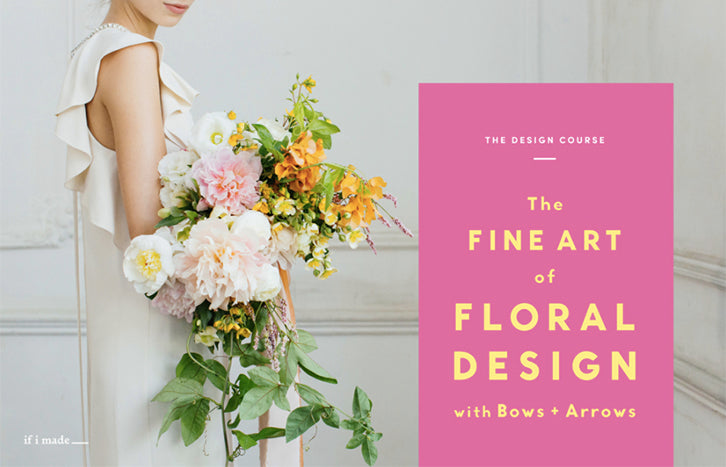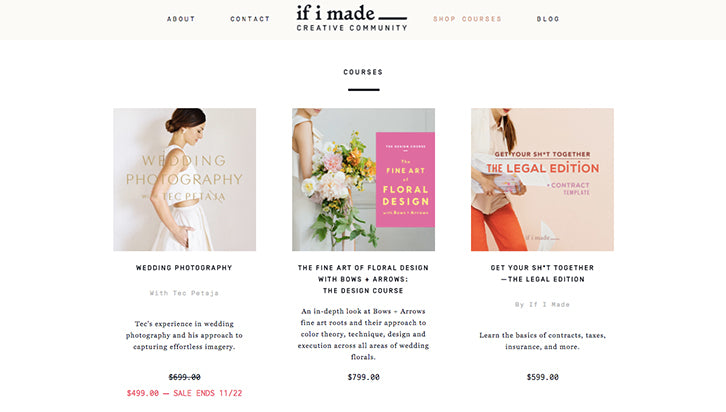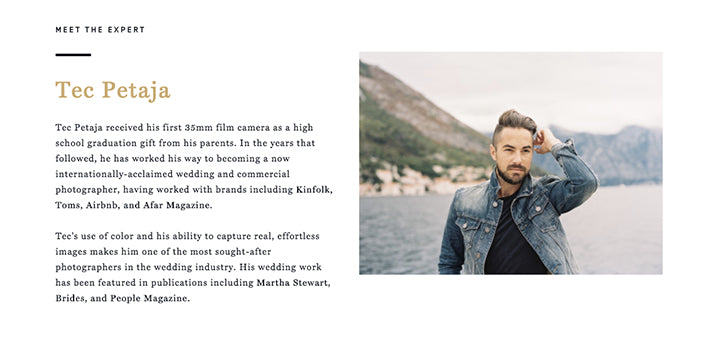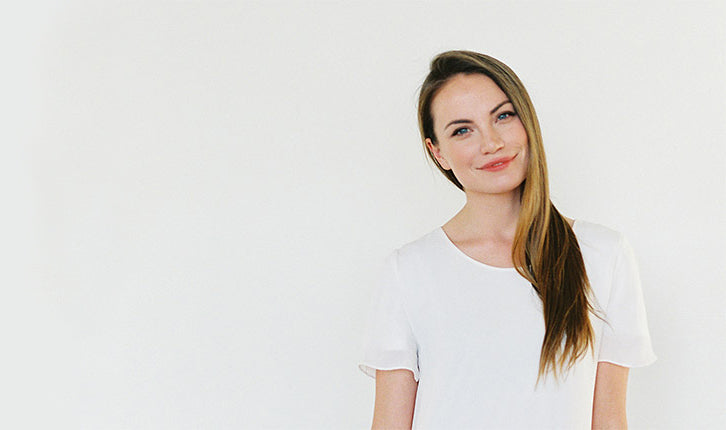“I’ve never been a wedding person,” says Emily Newman. Eight years ago, she and her husband skipped the fanfare and eloped.
Today, however, she’s the kingpin and creative genius behind hugely successful Once Wed, a wedding blog and dress listing service that welcomes 6 million yearly visitors. She’s been featured as a wedding expert in publications like the New York Times and Cosmo Bride, and contributed as creative director on campaigns for the likes of Fuji Film and Allure.
A year ago, Emily added a new notch to her entrepreneurial bedpost. Along with a partner—stylist and photographer Joy Thigpen—she launched If I Made on Shopify last October, selling digital courses to creative professionals.
Education, at first, may seem like another strange leap for Emily—she didn’t pursue formal education for herself, after all. But, it’s the perfect venture for a self-directed learner. She taught herself marketing and business skills, and developed her creative prowess by working on set with pros.
She understands first-hand that education comes in many forms, and that the future of learning likely exists outside of a college lecture hall.
The culmination of Emily’s experiences is a beautiful extension of the Once Wed brand—a brand built on a reputation of highly curated content. She and Joy simply pivoted that content into learning.
A deep understanding of audience, a commitment to listening, and leveraged relationships with experts have been the keys to the success of If I Made. The year-young company has now sold ecommerce classes (at an average of $700 a pop) to over 2000 professionals
Selling Courses Online 101: entrepreneurs looking to tap into the booming elearning industry can easily sell education online through Shopify. Read to the bottom of this post for tips, tools and resources to help you get started.
We spoke to Emily about her own journey in building her business. This is her story.
Once Wed
After high school, Emily knew college wasn’t for her. She was modelling at the time, and her agency offered an opportunity to live and work in Bangkok. While she spent most of her time there in front of the camera, it was the behind-the-camera action—the creative process—that excited her.
The realization coincided, as fate would have it, with her impending elopement.
When Emily was getting married, she wanted a beautiful dress but couldn’t justify the price tag. She realized other women were facing the same dilemma.
“When I was growing up, my parents were deal finders. We always bought used cars, we always bought used clothes. When I tried on a dress and fell in love with it, it was way out of my budget, but I just felt like, ‘I know I can find this used.’ Back then there was really only eBay or Craigslist. There wasn't a platform specific for wedding dresses. What I found is a lot of women back then were using The Knot forums to sell and buy dresses. I saw an opportunity for a platform for women looking to do the same thing I was doing."
Her upbringing not only taught her to find a great deal, it also prepared her for small business life. “Both my parents are entrepreneurs,” she tells me. “They taught me that opportunity is out there, you just have to look for it.”
After her own nuptials, she launched Once Wed as a wedding dress listing service. She offered the service at no charge, with the aim of growing it quickly.

“My goal was to build out this large database of dresses and increase our traffic so that we could eventually sell advertising. That's how we generated revenue. We still generate 90 percent of our revenue through online advertising. We have a premium listing option now, too, which accounts for the other 10 percent.”
With Once Wed, Emily made the deliberate decision to not be involved in the transaction, even though she could have made a percentage of each sale. She simply provides the platform for buyer and seller to communicate.
“I started Once Wed when was 21. I had no marketing background, I had no graphic design or online background. My resources were really limited because it was a self-funded venture. If we had been involved in the actual transaction, like being the go-between, we could have charged a lot more. But that would have meant being on the hook for a lot more, and we'd probably have to hold inventory. I just wanted to keep things really lean and be able to grow quickly."
I started Once Wed when was 21. I had no marketing background, I had no graphic design or online background.
Eventually, Emily layered on a blog. Initially she started it to help drive traffic to the listing service, but the original content resonated with the bridal set, and it became an integral part of the business.
“We started getting a lot of notoriety and awareness for how we curated content. Over time, it grew into one part resource (the used wedding dresses) and one part inspiration (the blog). Now, we also have a listing service for vendors to advertise their professional services to brides.”
Through the Once Wed blog, she came full circle, fulfilling her dreams of working behind the camera.
Making If I Made
Last year, Emily and her team wanted to take the business in a new direction. They just didn’t know which direction. They were seven years into Once Wed by then, and the audience had grown significantly.
She ran an insight survey to learn more about that audience.
Unsurprisingly, the bulk of her readers were brides, but the results told them that the most loyal in their audience were creative and wedding industry professionals—photographers, planners, florists, and caterers alike. The survey also captured the pain points of this segment of the audience.
Of those concerns, one stood out: access to good continuing education resources for professionals in their fields.
“From that survey, we found an opportunity and we released our first course last October. Wedding Styling 101 was an in-person workshop curriculum taught by Joy and myself. We then took that content and brought it all online to make it more portable and accessible. A lot of people in our industry took the course and really liked it. From there, we just started branching out. We've done some photography courses, floral design courses.”


As a spin off from Once Wed, If I Made enjoyed a built in audience, and the long-tended relationships with creatives who would become the instructors of their expanding course catalog.
They aimed to stand out from the likes of Skillshare and Creative Live, by placing the focus on the instructors rather than the actual topic. Their existing network made it easy. To appease different learning styles, If I Made aims to work with various experts within the same subject.
“We really don't believe there's one way of doing something. That's why we want to have courses from many different photographers. Everyone's got their own unique perspective and creative process. We also partner with specific experts within an industry because we believe that our students care more about who's teaching the course than the subject matter. They don't want to learn from just any photographer.”
True to their commitment to great original content, course development involves a team of creatives who develop stunning course materials in partnership with the course instructor.


“Our courses are a combination of worksheets, PDFs, and video. I've got a team of really talented writers and designers. We're doing everything from building out the initial framework for the curriculum, to sourcing and creating imagery, interviewing the expert, filming the curriculum from beginning to end, including storyboarding the production, hair and makeup, and models. A lot of what we're bringing to the table is coming from what I learned over the years at Once Wed. A big part of my job was creating content. We weren't aggregate only—we were internally trying to create content and push the industry forward.”
We create the course content from beginning to end. We write it. We produce it. We photograph it. We film it. I've never been to school for any of this.
Though Once Wed’s success relied on the contributions of many people, it was essentially Emily’s one-woman show. If I Made, on the other hand, was the brainchild of a partnership.
I ask Emily what she’s learned from the experience, now that she has a year under her belt. What advice could she offer others starting a business with a partner?
“Probably the biggest thing I've learned about being in a partnership is that you can’t ask enough questions before getting into a business with someone. It's like getting married in a lot of ways, legally. It's asking questions like: what is healthy work life balance for you? What do you want from your life in 10, 20, 30 years? What happens if we disagree on something? How do you handle conflict? Things like that. I think that's been the biggest eye-opener for me is that it's really like you almost want to court someone before you ‘marry’ them in a business partnership."
If I Made also involves more complex partnerships with its stakeholders: the experts lending their names and brains to the content. Their existing relationships with these creatives helped to sell the idea.

“Since a lot of the experts are people that we know personally, it wasn't as much of a risk. Anytime you start a new venture I feel like it's risky for the person on our side but it's also risky for the person we're offering the opportunity to. Is this going to be a good fit for their brand? Are they going to get something out of it? I feel like when you know someone, it's much easier to say, ‘Hey, give us a chance. I think this could work.’”
“Use contracts,” Emily urges. She understands that people are naturally wary of contracts, but has learned the value of putting pen to paper.
The women chose their expert partnerships strategically. They went after creatives with built-in audiences, strong creative voices, and a reputation in the industry. Many of the pros already run their own workshops, and the If I Made partnership allowed them to bring that content to a wider audience, making the relationship mutually beneficial.
The course flow has also been structured to accommodate the busy lives of the instructors. The content is thorough, pre-recorded, and self-paced for the learners.
“We offer a Q&A follow-up webinar that allows people one on one access to the experts. We're talking about in the future about how can we give people even more access to the experts, but a lot of the experts that we're talking to, they're running their own businesses. It's this fine balance between making them accessible, but allowing them time to grow their own brands and their own businesses. Doing a 12 week course, being available every week just doesn't make sense for most of the experts.”
She’s also learned through experience that business decisions rely on a mix of intuition and numbers. If I Made isn’t the first pivot she’s made, and others have failed because, she says, she “leaned too hard into intuition.”
It doesn't matter how much you want something. If the numbers don't work, it's going to be hard for it to be a sustainable, growing, profitable business.
When Emily launched If I Made, she had the benefit of an existing audience, years of experience creating content, and a robust network of creatives. Though she’s been incredibly successful, she is quick to remind me that every small business has its ups and downs.
“It's easy to look at people online and think that success happens overnight or that they're still not sacrificing or struggling to make ends meet. That is a façade. Most of the entrepreneurs that I know that are self-starters, and especially for ones that are self-funded, there are seasons of really great growth and then there are seasons of not great growth. I still experience that as an entrepreneur. I know that's what I signed up for when I chose this path.”
Selling Courses Online
What will you teach? This process may look very similar to choosing a physical product to sell: what do you know? Where do gaps exist? What does keyword research tell you? What’s popular on Skillshare, for example? Can you do it better?
Determine the format of the course. Your content may be delivered via pre-recorded video, written materials, live video/webinars, or a combination of these formats.
30+ Tools, Apps, and Resources
However you decide to create and deliver your course, there are plenty of free and inexpensive tools to help you create professional looking content:
- Webinars/live content: Google Hangouts, GotoWebinar, YouTube Live, Facebook Live
- Screencasts: Jing, ScreenFlow
- Design tools: Canva Infographic Maker, GIMP, Skitch
- Written content: Hemingway, Grammarly
- Publishing written content/PDFs: iBooks Author, Google Slides, PowerPoint, Keynote
- Video creation: Uscreen (custom integration with Shopify)
- Video editing: iMovie, Windows Movie Maker, Avidemux, Wondershare Filmora
When shooting prerecorded video or broadcasting a live webinar, a simple set-up using your iPhone can still look professional with a few inexpensive add-ons, like a small tripod, basic lighting kit, and external mic.

photo: Wistia
If the DIY route is over your head, consider sending your raw content to freelancers via Upwork, 99Designs, Shopify Design Experts, or Fiverr.
To sell courses (or any digital products) on Shopify, layer on a few handy apps to help make the checkout and delivery process smooth for your customers:
- Avizr: create online courses, including video content, web pages, and surveys
- Digital Downloads or SendOwl: ideal tools for delivering digital course material to customers instantly
- Easy Video: adds video to product pages (use to preview video course content)
- Recurring Payments: consider offering subscription access to course content with recurring payments
- Powr Survey: collect course feedback from your customers
- EVM Testimonials: Showcase student feedback as testimonials on your Shopify store

Also consider:
- Affirm: financing for your customers (Shopify partnership)
- LockLizard: safeguard your intellectual property and prevent copying and sharing of your materials
8 Tips for Success
Through Emily’s story, we’ve put together our eight top tips to help you launch and grow your own online education business on Shopify:
1. Build your list: develop free content like webinars or condensed versions of courses to help you build your email list. If I Made still uses free content to grow the business, too:
“We offer webinars not only to promote our courses but also to partner with new creatives and give people access to them. This is a way to add value and give back to our community and make experts in our industry more accessible.”
2. Establish trust: start with bite-sized courses, or sell larger courses as “modules”. Lower price points may alleviate customer fear of dropping hundreds of dollars on an unknown. A well branded domain can also help build trust. If you need ideas, try our website name generator.
3. Gather feedback at every stage, says Emily:
"We do a lot of research before the course, but also during and after. We send out surveys after every course to make sure people are happy. It’s important to us that people feel like they're walking away with tangible, actionable lessons that they can implement into their businesses. Also, the survey gives us an ear into what they're struggling with, what they’re looking to learn, and how they’re wanting to further their craft."
It’s important to us that people feel like they're walking away with tangible, actionable lessons that they can implement into their businesses.
4. Be transparent: your product pages and FAQs should help manage learner expectations. Clearly describe course content and format (what’s included?), how it will be delivered, learning objectives, support, and level of difficulty (what are the “prerequisites”?)


5. State your refund policy, and make it generous. If I Made offers a 30-day money back guarantee on all courses:
“If you get a course and it's not what you're expecting or it's not aligned with your needs, all we ask is that you can fill out a small survey that we can get back to the expert. It’s insight that helps us understand why this customer was disappointed and how we avoid it in the future.”
6. Focus on repeat customers: build your courses up from your most popular, offering more options or levels within the same topic. Consider the journey of your existing customers, Emily says:
“We need to make sure that the content doesn't start to feel too repetitive as we add more courses. As our library expands, if someone takes three of our photography courses, we have to make sure it’s still a valuable investment for them and they're still going to walk away learning something new."
7. Add a community element: use private Facebook groups to communicate with learners and foster sharing
8. Be flexible: understand that learning styles and paces vary. Accommodate busy part-time learners with a self-paced format.
“Some of our learners, they get the course and immediately read it in 4 or 5 days. They just want to jump right into the content and go at it. Some people spread it over the course of weeks.”

If I Made continues to evolve, exploring new audiences and ways to get content in front of them. A high school class recently tuned into an If I Made floral design webinar.
“High school students were able to learn from one of the top floral designers in the world because their teacher is letting them tune in during their classroom time. That just wasn't possible 15 years ago when I was in high school. I feel like online education is just going to explode.”
If education continues to trend away from the traditional, Emily's a shoe-in for "Most Likely to Succeed".
Topics:
Join 446,005 entrepreneurs who already have a head start.
Get free online marketing tips and resources delivered directly to your inbox.
Thanks for subscribing
You’ll start receiving free tips and resources soon. In the meantime, start building your store with a free 14-day trial of Shopify.





